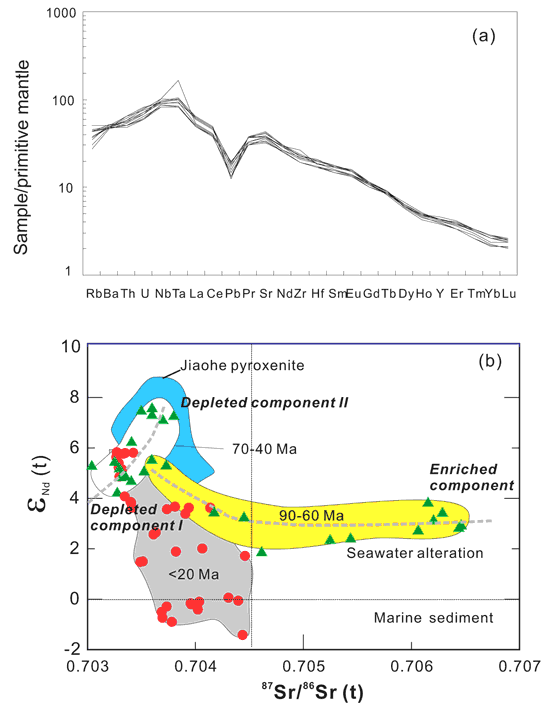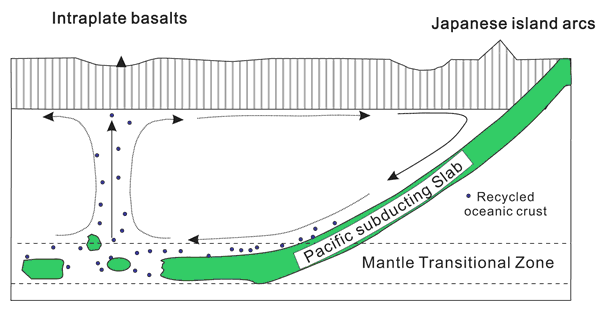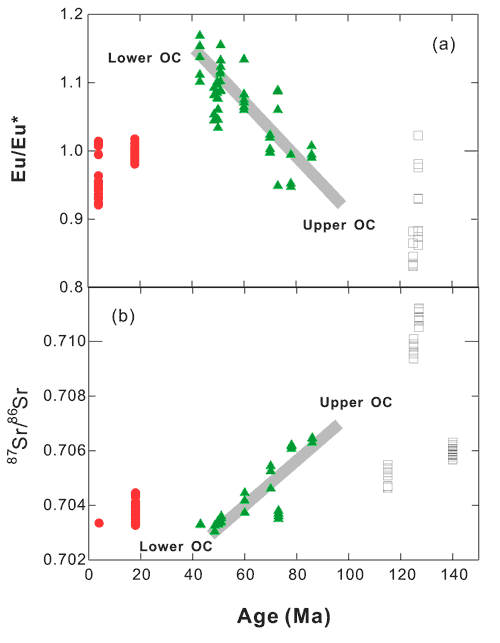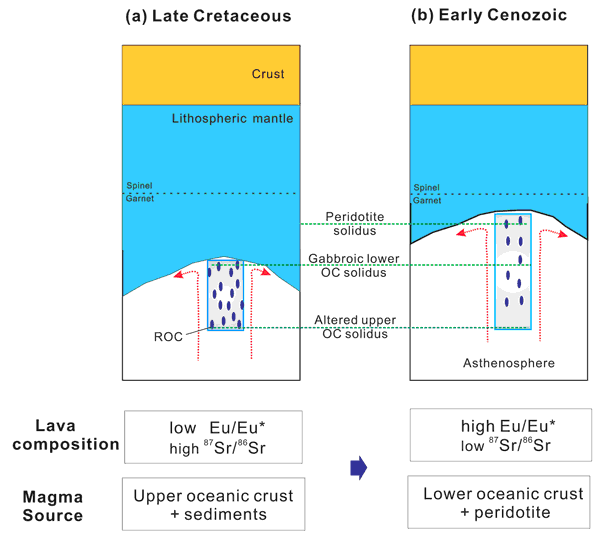|
Yi-Gang Xu
State Key Laboratory of Isotope Geochemistry, Guangzhou Institute of Geochemistry, Chinese Academy of Sciences, Guangzhou, 510640, China; yigangxu@gig.ac.cn
The North China Craton (NCC) experienced thermo-tectonic reactivation, during which a > 100 km thick lithospheric keel under its eastern part was removed (Menzies et al., 1993). A low thermal gradient (~40 mw/m2; Griffin et al., 1998; Xu, 2001) in the lithospheric mantle is shown by refractory peridotite xenoliths enclosed in Ordovician diamondiferous kimberlites. This, together with low 187Os/188Os ratios in the xenoliths (<0.113), indicates an old, thick, cold cratonic keel beneath the NCC during the Paleozoic. In contrast, a high thermal gradient (~60 mw/m2; Xu, 2001) is shown by fertile, oceanic-type peridotites in Cenozoic basalts (Gao et al., 2002; Hong et al., 2012). This implies considerable lithospheric thinning beneath the NCC during the late Mesozoic. This presents a major problem in the study of the cause and mechanism of continental lithospheric thinning, because cratonic keels are thought to be stable due to their buoyancy and the low density of highly melt-depleted peridotites (3.3-3.35 g/cm3) (O’Reilly et al., 2001; Lee, 2003).
So far, several potential triggers have been proposed as causes for destabilization of the NCC. These include:
-
the India-Eurasia collision (Menzies et al., 1993);
-
mantle plume activity (Deng et al., 2005);
-
the Yangtze-North China collision (Menzies & Xu, 1998; Gao et al., 2002); and
-
subduction of the Pacific plate underneath the east Asian continent (Griffin et al., 1998; Xu, 2001; Niu, 2005; Wu et al., 2008).
Among these, subduction of the Pacific plate is now regarded as one of the principal triggers for the destruction of the NCC (Zhu et al., 2012). It is therefore a challenge for petrologists and geochemists to identify slab-derived materials involved in the sources of the Mesozoic-Cenozoic magmas in this region.
Identification of components contributing to the genesis of mafic magmas is one of the major geochemical challenges in understanding the dynamics of the Earth's mantle (Zindler & Hart, 1986). Despite much work, the origin of intraplate alkaline basalts still remains unclear. Earlier experiments demonstrated that alkali basalts form at higher pressure, via a smaller degree of partial melting of peridotites, compared to tholeiites. However, it has been repeatedly stated in recent years that melts derived from a peridotitic source are not the same, compositionally, as oceanic island basalts (OIB) and alkaline basalts in general. Pyroxenite, eclogite, or carbonated peridotites and eclogites are considered possible candidates instead of peridotites for the source of alkaline basalts (e.g., Kogiso et al., 2003; Dasgupta et al., 2006).
Recent studies have shown the ubiquitous presence of subduction-related components in late Cenozoic basalts in eastern China (Zhang et al., 2009; Xu et al., 2012; Sakuyama et al., 2013). However, it remains unclear whether similar recycled oceanic components are present in earlier basalts. Xu (2014) compiled major, trace element and Sr-Nd-Pb isotopic data of basalts emplaced at 90-40 Ma in the N and NE China, and identified three major components in the magma source, including depleted components I and II, and an enriched component (Figure 1). Depleted component I, which is characterized by relatively low 87Sr/86Sr (<0.7030), moderate 206Pb/204Pb (18.2), moderately high εNd (~4), high Eu/Eu* (>1.1) and HIMU-like trace element characteristics, is most likely derived from gabbroic cumulates from oceanic crust. Depleted component II, distinguished by high εNd (~8) and moderate 87Sr/86Sr (~0.7038), is probably derived from sub-lithospheric ambient mantle. The enriched component has low εNd (2-3), high 87Sr/86Sr (>0.7065), low 206Pb/204Pb (17), excess Sr, Rb, Ba and a deficiency of Zr and Hf relative to the REE. This component is likely from the basaltic portion of oceanic crust, which is variably altered by seawater and contains minor sediments. Comparison with experimental melts and trace-element modeling suggest that these recycled oceanic components may be in the form of garnet pyroxenite/eclogite. They are young (<0.5 Ga) and show an Indian-MORB isotopic character. Given the similarity of these isotopic characteristics to the extinct Izanaghi-Pacific plate, currently stagnated in the mantle transition zone, it is proposed that it ultimately arises from the subducted Pacific slab (Figure 2).

Figure 1: (a) Primitive mantle-normalized trace element diagrams for representative samples of the 90-40 Ma basalts from N and NE China. (b) εNd versus 87Sr/86Sr.

Figure 2: Cartoon illustrating recycled oceanic crustal components in intraplate basalts, which are likely derived from the stagnant slab within the mantle transition zone (Huang & Zhao, 2006).
Eu/Eu* and 87Sr/86Sr of the 90-40 Ma magmas increase and decrease, respectively, with decreasing emplacement age (Figure 3), mirroring a change in magma source from upper to lower parts of subducted oceanic crust. Such secular trends are created by dynamic melting of a heterogeneous mantle containing recycled oceanic crust. Due to the different melting temperatures of the upper and lower oceanic crust and progressive thinning of the lithosphere, the more fertile basaltic crustal component is preferentially sampled during the early stage of volcanism, whereas the more depleted gabbroic lower crust and lithospheric mantle components are preferentially sampled during a later stage (Figure 4). This model is consistent with a protracted destruction process for the lithosphere beneath E China. The presence of significant recycled oceanic crust components in the 90-40 Ma basalts highlights the influence of Pacific subduction on deep processes in the NCC, which can be traced back at least to the late Cretaceous. This, along with the conjugation of the crustal deformation pattern in this region with the movement of the Pacific plate, makes Pacific subduction a potential trigger for the destruction of the NCC.

Figure 3: Plots showing increasing Eu/Eu* and decreasing 87Sr/86Sr in the 90-40 Ma basalts (MgO > 8 wt%) with decreasing age. Since the upper oceanic crust (OC) has lower Eu/Eu* and higher 87Sr/86Sr than the lower OC, the trends point to a change in magma source from upper OC to lower OC.

Figure 4: Cartoon illustrating dynamic melting of a heterogeneous mantle during lithospheric thinning that can explain the temporal variation in composition of the 90-40 Ma basalts from N and E China. The solidus curves for upper oceanic crust (OC), lower OC and peridotite are indicated schematically. Rectangular boxes denote melting columns which consist of a recycled oceanic crustal (ROC) component and a peridotitic matrix. The melting columns extend from the asthenospheric solidus to the base of the lithosphere. (a) During the late Cretaceous, the lithosphere was relatively thick and the melting column was mostly confined to large depths, where only the upper part of ROC (i.e. eclogite/pyroxenite) with low-melting-point melts generating high-alkaline basalts with low Eu/Eu* and high 87Sr/86Sr. (b) During the early Cenozoic, the melting column migrated to a relatively shallow level as a result of lithospheric thinning, and the solidus of the lower OC was crossed. The magmas generated during this period represent pooled melts from both lower- and upper OC. Because of the consumption of the upper OC during previous melting events, the magmas are predominantly from the lower OC, showing high Eu/Eu* and low 87Sr/86Sr.
The NCC is relatively small compared to other cratons. It experienced multiple subductions from different directions, i.e., northward subduction of the Tethys ocean along the Dabie Shan and Song Ma sutures, south-dipping subduction along the Solonker (Permo-Triassic age) and Mongol-Okhotsk suture (Jurassic age), and westward subduction of Pacific plate. Large amounts of water are released from subducting slabs to the upper mantle under the eastern NCC (Windley et al., 2010). This is supported by recent estimates of the water content in the late Mesozoic lithospheric mantle under the eastern NCC of >1000 ppm (Xia et al., 2013). Water would have considerably weakened the lithosphere (Hirth & Kohlstedt, 1996; Li et al., 2008), facilitating its convective removal and leading to cratonic destruction. Pacific subduction underneath eastern Asia appears to have played a determinant role in cratonic destruction, governing the distribution patterns of post-Mesozoic basins and major tectonic configurations, the temporal change of magmatism, and east-west contrast in lithospheric architecture.
References
-
Dasgupta, R., Hirschmann, M.M., Stalker, K., 2006. Immiscible transition from carbonate rich to silicate-rich melts in the 3 GPa melting interval of eclogite+CO2 and genesis of silica-undersaturated ocean island lavas. J. Petrol. 47, 647-671.
-
Deng, J.F., Mo, X.X., Zhao, H.L., Wu, Z.X., Luo, Z.H., Su, S.G., 2005. A new model for the dynamic evolution of Chinese lithosphere: ‘continental roots–plume tectonics’. Earth-Sci. Rev. 65, 223-275.
-
Huang, J.L., Zhao, D.P., 2006. High-resolution mantle tomography of China and surrounding regions. J. Geophys. Res. 111, B09305
-
Gao, S., Rudnick, R.L., Carlson, R.W., McDonough, W.F., Liu, Y.S., 2002. Re-Os evidence for replacement of ancient mantle lithosphere beneath the North China Craton. Earth Planet. Sci. Lett. 198, 307-322.
-
Griffin, W.L., Zhang, A.D., O'Reilly, S.Y., Ryan, G. 1998. Phanerozoic evolution of the lithosphere beneath the Sino-Korean Craton. In Flower, M., Chung, S.L., Lo, C.H., Lee, T.Y., eds. Mantle dynamics and plate interactions in east Asia. Am. Geophys. Union Geodyn. Ser. 27, 107-126.
-
Hirth, G., Kohlstedt, D.L., 1996. Water in the oceanic upper mantle: Implications for rheology, melt extraction and the evolution of the lithosphere. Earth Planet. Sci. Lett. 144, 93-108.
-
Hong, L.B., Xu, Y.-G,. Ren, Z.Y., Kuang, Y.S., Li, J.. 2012. Petrology, geochemistry and Re-Os isotopes of peridotite xenoliths from Yantai, Shandong Province: Evidence for Phanerozoic lithospheric mantle beneath eastern North China Craton. Lithos 155, 256-271.
-
Huang, J.L., Zhao, D.P., 2006. High-resolution mantle tomography of China and surrounding regions. J. Geophys. Res. 111, B09305.
-
Kogiso, T., Hirschmann, M.M., Frost, D.J., 2003. High-pressure partial melting of garnet pyroxenite: possible mafic lithologies in the source of ocean island basalts. Earth Planet. Sci. Lett. 216, 603-617.
-
Lee, C.-TA., 2003. Compositional variation of density and seismic velocities in natural peridotites at STP conditions: implications for seismic imaging of compositional heterogeneities in the upper mantle. J. Geophys. Res. 108, (B9), DOI: 10.1029/2003JB002413.
-
Li, Z.X.A., Lee, C.T., Peslier, A.H., Lenardic, A., Mackwell, S.J., 2008. Water contents in mantle xenoliths from the Colorado Plateau and vicinity: Implications for the mantle rheology and hydration-induced thinning of continental lithosphere. J. Geophys. Res. 113 (B9), B09210.
-
Menzies, M.A., Fan, W.M., Zhang, M., 1993. Palaeozoic and Cenozoic lithoprobes and the loss of > 120 km of Archaean lithosphere, Sino-Korean craton, China. In: Prichard, H.M., Alabaster, T., Harris, N.B.W., Neary, V.R (Eds), Magmatic processes and plate tectonics. Geol. Soc. Spec. Pub. 76, 71-78.
-
Menzies, M.A., Xu, Y.G., 1998. Geodynamics of the N China Craton. In: Flower, M., Chung, S.L., Lo, C.H., Lee, T.Y., eds. Mantle dynamics and plate interactions in east Asia. Am. Geophys. Union Geodyn. Ser. 27, 155-165.
-
Niu, Y.L. 2005. Generation and evolution of basaltic magmas: some basic concepts and a new view on the origin of mesozoic-cenozoic basaltic volcanism in Eastern China. Geol. J. China Universities 11, 9-46.
-
O'Reilly, S.Y., Griffin, W.L., Poudjom Djomani, Y.H., Morgan, P., 2001. Are lithospheres forever? Tracking changes in subcontinental lithospheric mantle through time. GSA Today 4–9.
-
Sakuyama, T., Tian, W., Kimura, J.-I., et al., 2013. Melting of dehydrated oceanic crust from the stagnant slab and of the hydrated mantle transition zone: constraints from Cenozoic alkaline abasalts in eastern China. Chem. Geo. 359, 32-48.
-
Windley, B.F., Maruyama, S., Xiao, W.J., 2010. Delamination/thinning of sub-continental lithospheric mantle under Eastern China: The role of water and multiple subduction. Am. J. Sci. 310, 1250-1293.
-
Wu, F.Y., Xu, Y.G., Gao, S., Zheng, J.P., 2008. Controversial on studies of the lithospheric thinning and craton destruction of N China. Acta Petrologica Sinica 24, 1145-1174.
-
Xia, Q.K., Liu, J., Liu, S.C. et al., 2013. High water content in Mesozoic primitive basalts of the N China Craton and implications on the destruction of cratonic mantle lithosphere. Earth Planet. Sci. Lett. 361, 85-97.
-
Xu, Y.G., 2001. Thermo-tectonic destruction of the Archaean lithospheric keel beneath the Sino-Korean craton in China: evidence, timing and mechanism. Phys. Chem. Earth 26, 747-757.
-
Xu Y.G., 2014. Recycled oceanic crust in the source of 90-40 Ma basalts in N China Craton: Evidence, provenance and significance. Geochim. Cosmochim. Acta, 10.1016/j.gca.2014.04.045
-
Xu, Y.G., Zhang, H.H., Qiu, H.N., Ge, W.C., Wu, F.Y., 2012. Oceanic crust components in continental basalts from Shuangliao, Northeast China: Derived from the mantle transition zone? Chem. Geol. 328 , 168-184.
-
Zhang, J.-J., Zheng, Y.-F., Zhao, Z.-F., 2009. Geochemical evidence for interaction between oceanic crust and lithospheric mantle in the origin of Cenozoic continental basalts in east-central China. Lithos 110, 305-326.
-
Zhu, R.X., Xu, Y.G., Zhu, G., Zhang, H.F., Zheng, T.Y., 2012. Destruction of the N China Craton. Science in China (D) 55, 1565-1587.
-
Zindler, A., Hart S. R., 1986. Chemical geodynamics. Ann. Rev. Earth Planet. Sci. 14, 493-571.
last updated 19th
June, 2014 |
